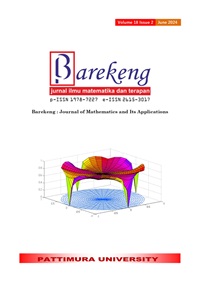MODELING CHRONIC FILARIASIS CASES IN WEST JAVA USING A MULTIVARIATE ADAPTIVE APPROACH REGRESSION SPLINES
Abstract
One of the most crippling infectious diseases in the world is filariasis. Indonesia is a unitary country with 34 provinces, where West Java is one of the 5 provinces with the most filariasis sufferers in Indonesia as of 2021. Reinfection occurs in places that have implemented POMP. Therefore, monitoring operations must be carried out to track the emergence of new cases and risk factors for transmission. The aim of this research focuses on describing and modeling the number of chronic filariasis in West Java, as well as interpreting the best model results obtained. The method used is a method with a nonparametric regression approach, namely Multivariate Adaptive Regression Spline. The results of the research show that the best model obtained is a combination of 15 base functions, maximum interaction 2, and minimum observation between knots 1. From this model, the predictor variable that has the most influence on the response variable in order based on the level of variable importance is the Percentage of Population Access to Facilities Decent Sanitation, Percentage of Households with Clean and Healthy Behavior (PHBS), Sex Ratio, and Percentage of Poor Population. The interpretation of the best model is that the variable Percentage of Population Access to Adequate Sanitation Facilities above 6,650% will contribute to a reduction in the number of chronic filariasis; the Sex Ratio variable below 103,300 will contribute in the form of a reduction in the number of chronic filariasis. it can be seen that the predictor variable that has the most influence on the response variable is the variable Percentage of Population Access to Proper Sanitation Facilities with an importance level of 100%.
Downloads
References
R. Amelia, “Analysis of Risk Factors for Filariasis”, Unnes Journal of Public Health, vol. 3, no. 1, pp. 2-3, March 2019.
R. Novita, “The Impact of Climate Change on the Emergence of Mosquito Transmitted Diseases, Especially Lymphatic Filariasis”, Journal of Health Epidemiology and Communicable Diseases, vol. 5, no. 1, pp. 30-39, May 2019.
World Heath Organization. “Lymphatic Filariasis: Reporting Continued Progress Towards elimination as a Public Health Problem” Address: https://www.who.int/news/item/29-10-2020-lymphatic-filariasis-reporting-continued-progress-towards-elimination-as-a-publichealth-problem [accessed Juli. 03, 2021].
Indonesian Ministry of Health, Indonesian Health Profile. Jakarta : Directorate General of Disease Prevention and Control (P2P) Ministry of Health of the Republic of Indonesia, 2021.
West Java Provincial Health Service. Bandung : Filariasis Situation in West Java Province 2007-2011. West Java Provincial Health Service, 2017.
Wicaksono, “Multivariate Adaptive Regression Spline (MARS) Modeling on Risk Factors for Diarrhea Disease Rates”, Gaussian Journal, vol. 3, no. 2, pp. 253- 262, June 2014.
F. Lembang, “Analysis of Poverty in West Southeast Maluku Regency Using the Multivariate Adaptive Regression Spline (MARS) Approach, Journal of Media Statistics”, Journal of Media Statistics, vol. 12 no. 2, pp. 188-199, December 2019.
Bappenas. Jakarta:UNDP. Indonesia: Progress Report on Achieving the Millennium Development Goals, 2016.
V. Wiratna, Quantitative Qualitative Research Methods and R&D. Bandung: Alphabeta Bandung, 2014.
A. Sholikhah. “Descriptive Statistics in Qualitative Research”, Journal of Communication, vol. 10, no. 2, pp. 342-362, December
Sugiyono, Quantitative, Qualitative and R&D Research Methods. Bandung: CV Alphabet, 2017.
Winarno, Research Methodology in Physical Education. Malang: UM Press, 2013.
L. Martias, “Descriptive Statistics as a Collection of Information”, FIHRIS: Journal of Library and Information Science, vol. 16, no. 1, pp. 40-59, January 2021.
Santoso, “Relationship between physical environmental factors and the incidence of filariasis in Indonesia,” Journal of Health Ecology, vol. 13, no. 3, pp. 210-218, September 2018.
P. Juriastuti, M. Kartika, IM. Djaja, D. Susanna, “Risk Factors for Filariasis in Jati Sampurna Village,” Makara Health, vol. 14 no. 1, pp. 31-36, June 2017.
Copyright (c) 2024 Ardi Kurniawan, Mochammad Firmansyah, Toha Saifudin

This work is licensed under a Creative Commons Attribution-ShareAlike 4.0 International License.
Authors who publish with this Journal agree to the following terms:
- Author retain copyright and grant the journal right of first publication with the work simultaneously licensed under a creative commons attribution license that allow others to share the work within an acknowledgement of the work’s authorship and initial publication of this journal.
- Authors are able to enter into separate, additional contractual arrangement for the non-exclusive distribution of the journal’s published version of the work (e.g. acknowledgement of its initial publication in this journal).
- Authors are permitted and encouraged to post their work online (e.g. in institutional repositories or on their websites) prior to and during the submission process, as it can lead to productive exchanges, as well as earlier and greater citation of published works.






1.gif)



